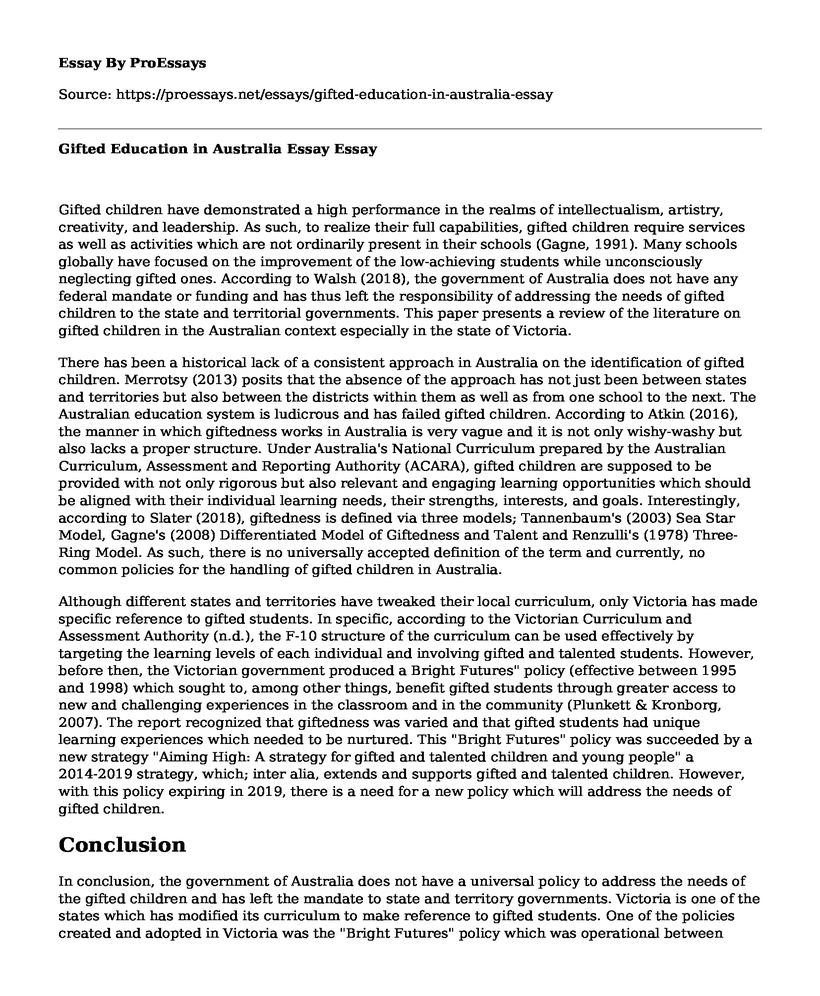Gifted children have demonstrated a high performance in the realms of intellectualism, artistry, creativity, and leadership. As such, to realize their full capabilities, gifted children require services as well as activities which are not ordinarily present in their schools (Gagne, 1991). Many schools globally have focused on the improvement of the low-achieving students while unconsciously neglecting gifted ones. According to Walsh (2018), the government of Australia does not have any federal mandate or funding and has thus left the responsibility of addressing the needs of gifted children to the state and territorial governments. This paper presents a review of the literature on gifted children in the Australian context especially in the state of Victoria.
There has been a historical lack of a consistent approach in Australia on the identification of gifted children. Merrotsy (2013) posits that the absence of the approach has not just been between states and territories but also between the districts within them as well as from one school to the next. The Australian education system is ludicrous and has failed gifted children. According to Atkin (2016), the manner in which giftedness works in Australia is very vague and it is not only wishy-washy but also lacks a proper structure. Under Australia's National Curriculum prepared by the Australian Curriculum, Assessment and Reporting Authority (ACARA), gifted children are supposed to be provided with not only rigorous but also relevant and engaging learning opportunities which should be aligned with their individual learning needs, their strengths, interests, and goals. Interestingly, according to Slater (2018), giftedness is defined via three models; Tannenbaum's (2003) Sea Star Model, Gagne's (2008) Differentiated Model of Giftedness and Talent and Renzulli's (1978) Three-Ring Model. As such, there is no universally accepted definition of the term and currently, no common policies for the handling of gifted children in Australia.
Although different states and territories have tweaked their local curriculum, only Victoria has made specific reference to gifted students. In specific, according to the Victorian Curriculum and Assessment Authority (n.d.), the F-10 structure of the curriculum can be used effectively by targeting the learning levels of each individual and involving gifted and talented students. However, before then, the Victorian government produced a Bright Futures" policy (effective between 1995 and 1998) which sought to, among other things, benefit gifted students through greater access to new and challenging experiences in the classroom and in the community (Plunkett & Kronborg, 2007). The report recognized that giftedness was varied and that gifted students had unique learning experiences which needed to be nurtured. This "Bright Futures" policy was succeeded by a new strategy "Aiming High: A strategy for gifted and talented children and young people" a 2014-2019 strategy, which; inter alia, extends and supports gifted and talented children. However, with this policy expiring in 2019, there is a need for a new policy which will address the needs of gifted children.
Conclusion
In conclusion, the government of Australia does not have a universal policy to address the needs of the gifted children and has left the mandate to state and territory governments. Victoria is one of the states which has modified its curriculum to make reference to gifted students. One of the policies created and adopted in Victoria was the "Bright Futures" policy which was operational between 1995 and 1998. Currently, gifted children's needs are addressed by the strategy "Aiming High: A strategy for gifted and talented children and young people" strategy which is set to expire in 2019 hence necessitating the creation of a more effective policy for the schooling of gifted children.
References
Atkin, M. (2016). 'Ludicrous' education system failing gifted children, parents and experts say Retrieved 18 July 2018, from http://www.abc.net.au/news/2016-11-22/education-system-failing-gifted-children-experts-say/8047468Gagne, F. (1991). Toward a differentiated model of giftedness and talent. Handbook of gifted education, 65-80.
Merrotsy, P. (2013). Invisible gifted students. Talent Development & Excellence, 5(2), 31-42.
Plunkett, M., & Kronborg, L. (2007). Gifted education in Australia: A story of striving for balance. Gifted Education International, 23(1), 72-83.
Rcrellin. (2014). Aiming High: A strategy for gifted and talented children and young people. Retrieved 18 July 2018, from http://global2.vic.edu.au/2014/05/27/aiming-high/
Slater, E. (2018). The identification of gifted children in Australia: The importance of policy. Retrieved 18 July 2018, from http://www.talented.org.au/the-identification-of-gifted-children-in-australia-the-importance-of-policy/
Victorian Curriculum and Assessment Authority (n.d.). Retrieved 18 July 2018, from http://victoriancurriculum.vcaa.vic.edu.au/
Walsh, R. L., & Jolly, J. L. (2018). Gifted Education in the Australian Context. Gifted Child Today, 41(2), 81-88.
Cite this page
Gifted Education in Australia Essay. (2022, Jun 22). Retrieved from https://proessays.net/essays/gifted-education-in-australia-essay
If you are the original author of this essay and no longer wish to have it published on the ProEssays website, please click below to request its removal:
- Mark Lilla: The Shortfalls of Identity Politics and American Liberalism
- Why I Want to Be a Paralegal Essay Example
- Travel to France: Project Sample
- Essay on Gender Roles in Modern Society: How Kids Learn Societal Expectations
- Construction of Asphalt Pavement in China - Essay Sample
- Essay on the Fight Against America's Drug Problem: The Role of Villages & Police
- Report Example on Achieving Healthcare Transformation: Quality Challenges & Rewards







